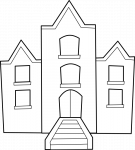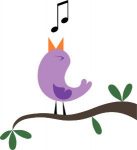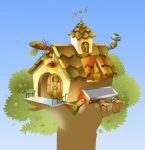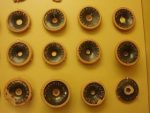This week students doing the Understanding Our World® program are exploring their environment and considering indigenous peoples. Younger students are learning about local history and planning a poster on a local issue. Older students are studying indigenous peoples around the world. All the students are working strongly on their main pieces of assessment for the term.
 Foundation/Prep/Kindy to Year 3
Foundation/Prep/Kindy to Year 3
Our youngest students, using the stand-along Foundation/Prep/Kindy unit (F.2) are exploring the sense of touch in their environment this week. Students consider a range of fabrics and textiles and choose which ones match their favourite place, for inclusion in their model or collage. Students in integrated classes of Foundation/Prep/Kindy and Year 1 (Unit F.6), Year 1 students (Unit 1.2), Year 2 students (Unit 2.2) and Year 3 (Unit 3.2) are starting to prepare a poster on an issue regarding their school, or local park/heritage place, while considering the local history. These investigations should be based on the excursion from last week. Students will have 2 weeks to prepare their posters, for display either at the school or a local venue, such as the library or community hall.
Years 3 to 6
 Students in Years 3 to 6 are continuing with their project on an explorer. Students in Year 3 (Unit 3.6) are examining Australian Aboriginal groups from extreme climate areas of Australia, such as the central deserts, or cold climate areas. Students then choose one of these groups to describe in their Student Workbook, and add to their presentation. Students in Year 4 (Unit 4.2) are studying indigenous peoples of Africa and South America. They will then select a group from the area visited by their explorer, to include in their presentation. Year 5 students (Unit 5.2) do the same with indigenous groups from North America; whilst year 6 students (Unit 6.2) have a wide range of resources on indigenous peoples from Asia to select for study and inclusion in their presentation. Resources are available on groups from across mainland Asia (such as the Mongols, Tatars, Rus, Han), as well as South-East Asia (such as Malay, Dyak, Dani etc.). This is the last section of work to be included in the presentation, and students will then finish their presentation and present it to the class.
Students in Years 3 to 6 are continuing with their project on an explorer. Students in Year 3 (Unit 3.6) are examining Australian Aboriginal groups from extreme climate areas of Australia, such as the central deserts, or cold climate areas. Students then choose one of these groups to describe in their Student Workbook, and add to their presentation. Students in Year 4 (Unit 4.2) are studying indigenous peoples of Africa and South America. They will then select a group from the area visited by their explorer, to include in their presentation. Year 5 students (Unit 5.2) do the same with indigenous groups from North America; whilst year 6 students (Unit 6.2) have a wide range of resources on indigenous peoples from Asia to select for study and inclusion in their presentation. Resources are available on groups from across mainland Asia (such as the Mongols, Tatars, Rus, Han), as well as South-East Asia (such as Malay, Dyak, Dani etc.). This is the last section of work to be included in the presentation, and students will then finish their presentation and present it to the class.

 Foundation/Prep/Kindy to Year 3
Foundation/Prep/Kindy to Year 3 NAPLAN’s over and it’s time to sink our teeth into the main body of curriculum work before mid-year reporting rolls around. Our younger students are using all their senses to study the environment and local area around them, whilst our older students are hard at work on their Explorer projects.
NAPLAN’s over and it’s time to sink our teeth into the main body of curriculum work before mid-year reporting rolls around. Our younger students are using all their senses to study the environment and local area around them, whilst our older students are hard at work on their Explorer projects. Students in Years 3 (
Students in Years 3 ( It’s NAPLAN week and that means time is short! Fortunately, the Understanding Our World™ program is based on 9 week units, which means that if you run out of time in any particular week, it’s not a disaster. Furthermore, we have made sure that there is plenty of catch-up time within the lessons, so that there is no need to feel rushed. This week students are getting into the nitty gritty of their term projects. Our youngest students are studying their surroundings at school and in the local area. Older students are getting to the core of their research projects.
It’s NAPLAN week and that means time is short! Fortunately, the Understanding Our World™ program is based on 9 week units, which means that if you run out of time in any particular week, it’s not a disaster. Furthermore, we have made sure that there is plenty of catch-up time within the lessons, so that there is no need to feel rushed. This week students are getting into the nitty gritty of their term projects. Our youngest students are studying their surroundings at school and in the local area. Older students are getting to the core of their research projects. Students in our standalone Foundation/Kindy/Prep class (
Students in our standalone Foundation/Kindy/Prep class ( Students in Year 3 (
Students in Year 3 ( It is hoped that by now all the school routine is shaking back down into place. No doubt you’ve all got ANZAC Day marked on your
It is hoped that by now all the school routine is shaking back down into place. No doubt you’ve all got ANZAC Day marked on your  Students in our stand-alone Foundation/Prep class (Unit
Students in our stand-alone Foundation/Prep class (Unit  Students in Year 3, doing the Unit
Students in Year 3, doing the Unit 
 Foundation to Year 3
Foundation to Year 3 Students in Years 3 to 6 (Units
Students in Years 3 to 6 (Units  The last week of our first unit – time to wrap up, round off, finish up any work not yet done and to perhaps get a preliminary taste of what’s to come in future units. Easter holidays are just around the corner. Our youngest students are having a final discussion about
The last week of our first unit – time to wrap up, round off, finish up any work not yet done and to perhaps get a preliminary taste of what’s to come in future units. Easter holidays are just around the corner. Our youngest students are having a final discussion about 
I was very impressed with the layout and design of the Mirobot. I purchased the kit which required soldering. The…
Ian Cunningham